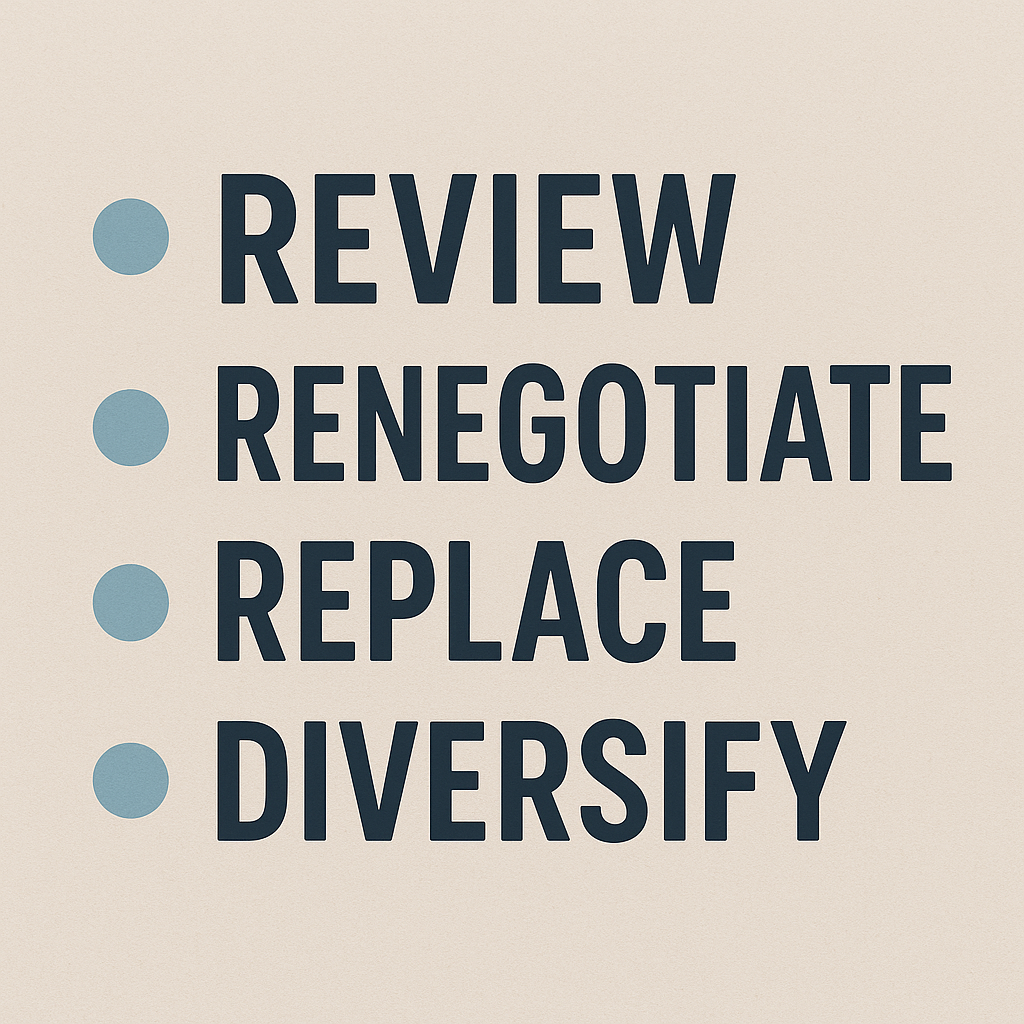
36/52 Nine Ways to Reduce Fixed Costs in a Small Business
17 September 2025
38/52 Profit Power: How Reinvesting Profit Fuels Business Growth
1 October 2025KEY CONCEPT: Reducing variable costs through better vendor negotiations and supply chain diversification is one of the most effective ways for small businesses to improve margins and drive growth in 2025.

This is 37th of 52 articles about what business owners can do to grow their businesses.
Introduction
Reducing variable costs through strategies that include better vendor negotiations and supply chain diversification is a powerful way for small businesses to improve margins and drive growth in 2025. Key areas to focus on include negotiation tactics, methods for diversifying supply, and broader strategies to optimise variable costs. [1]
Quick reminder: Growing a business isn’t just about more sales – margins matter.
Small increases over time from multiple suppliers can easily be overlooked; these can add up to a significant cost increase and erosion of your margins.
Promise: This post demonstrates how small business owners can negotiate better deals, diversify their supply chains, and reduce waste without compromising quality.
What Are Variable Costs (and Why They Matter)?
- Definition: Variable costs change depending on sales/production (e.g., raw materials, packaging, shipping, transaction fees, commissions). Variable costs (such as materials, shipping, and processing fees) increase with every unit sold, so optimising them has a multiplier effect.
A simple definition: Costs that scale with production or sales.
- Why it matters: Even small reductions here compound quickly since they’re tied to volume. Cutting £1 off each unit can mean thousands in additional profit. As our Grandmothers used to tell us – take care of the pennies and the pounds take care of themselves.
Small reductions at scale = significant margin gains.
- Examples: Raw materials, packaging, credit card fees, shipping, commissions.
1. Negotiate Better Vendor Deals
Build relationships with suppliers by emphasising long-term business potential and past purchase volume. Negotiate not only on price, but also on payment terms, discounts for early payment, bulk deals, and added value, such as improved delivery schedules or warranties. Compare offers from multiple suppliers to encourage competitive pricing, and do not accept the first offer without thoroughly discussing it and seeking a reduction. [4]
Consider long-term contracts for better rates while maintaining flexibility with pay-as-you-go models if that suits the business model. [5]
- Volume leverage: Consolidate orders or commit to longer contracts to unlock discounts. Long-term relationships can lead to preferential treatment, such as rebates, early-bird pricing, or loyalty discounts.
- Ask for better payment terms: Negotiate for extended terms (e.g., net 60 vs. net 30).
- Bundling: Combine multiple products and/or services from the same vendor for a lower overall rate.
- Always Competitive quotes: Always get multiple bids (at least 2 or 3); vendors often reduce prices when they know you’re comparing.
In summary, don’t just negotiate on price; also consider negotiating payment terms, delivery schedules, and additional extras.
2. Diversify Your Supply Chain
Avoid overreliance on a single supplier (the ‘all eggs in one basket’ syndrome) or region by sourcing from multiple suppliers and, where possible, from different geographic locations. This reduces the risk of disruptions from unforeseen events (like natural disasters or political instability) and fosters competition among suppliers, driving down costs and enhancing innovation. [3]
Working with a mix of larger and smaller vendors can offer more agility, innovative products, new opportunities, and sometimes better pricing or service to meet your business needs. [2]
- Avoid single-source risk: Relying on a single supplier for a critical input can leave you vulnerable to price hikes, shortages, or shipping delays.
- Domestic + international mix: Balance cost efficiency (imports) with reliability (local sourcing) where practical.
- Identify backup vendors: Have at least one alternative supplier for each critical input.
- Technology tools: Where practical, use supplier management software platforms to track performance, prices, and lead times.
- Mindset shift: Think of the supply chain as a profit driver, not just a cost centre.
3. Beyond Vendors: Other Variable Cost Levers
- Bulk Buying and Inventory Management:
Take advantage of volume discounts for high-turnover products, but avoid overstocking items with unpredictable demand or a short shelf life to prevent waste and unnecessary expenses. [1] - Operational and Productivity Optimisation:
Use sales data to optimise staffing, automate repetitive processes, and consider outsourcing functions where cost-effective. Implement technology and management software to enhance shift scheduling, inventory control, and purchasing, thereby further reducing per-unit costs. [9] - Employee Involvement:
Encourage employees to identify inefficiencies or suggest cost-saving ideas, especially regarding unused software licenses or more efficient operational processes. [11] - Building Business Credit:
A strong credit profile can help secure better vendor terms, resulting in lower costs for goods and services. [11] - Packaging optimisation: Smaller, lighter, or more eco-friendly packaging cuts material + shipping costs.
- Shipping carriers: Compare rates across carriers, use business shipping programs, and optimise routes.
- Energy + utilities: Shop around for utility providers and/or invest in energy-saving equipment.
- Transaction fees: Negotiate with credit card processors, explore ACH (automated clearing houses) or digital wallet options.
- Freelancers/contractors: Outsource flexibly rather than committing to fixed headcount when demand fluctuates.
4. Track and Monitor Costs Like a Pro
- Regular cost audits: Review costs and expenses quarterly; many businesses set it and forget it to their cost. Schedule periodic reviews to identify new savings opportunities as the market and business operations evolve. [11]
- KPIs to watch, measure and manage: Gross margin %, cost of goods sold (COGS), shipping as % of sales, transaction fees as a % of revenue, etc. Each business will have its own optimal KPIs (key performance indicators).
- Benchmarking: Compare costs against industry standards to see where you may be overspending.
- Pro tip: Small tweaks over time add up to compounding margin improvement.
5. Take a Strategic Perspective
- Your attitude is important. Consider short-term pain/discomfort for the sake of longer-term gain and success. However, reducing costs shouldn’t compromise quality or harm the customer experience.
- Don’t just cut — optimise: Reinvest savings and put margin gains into marketing, R&D, or customer service to fuel growth.
- Scenario planning: Model how changes in vendor costs (fuel surcharges, raw material spikes) affect margins and cash flow. Use these scenarios to create your backup plans.
For example, what happens if material costs rise 10%? Are you ready?
6. What else?
Here are three more strategies to consider.
- Consider Environmental and Local Sourcing Benefits:
Sometimes, local suppliers can offer better terms, more responsive service, and potential savings on shipping, as well as shorter lead times. This also strengthens the business’s local network and reputation. [8] - Budgeting and Forecasting:
Use market research to forecast demand accurately and set realistic procurement and inventory targets to minimise unnecessary spending and react swiftly to market changes. [12] - Supplier Relationship Management:
Maintaining open communication, being a reliable buyer, and taking a collaborative approach with suppliers often yields better deals and more flexible arrangements over time. [4]
A Quick Checklist for Business Owners or Managers
Before your next supplier call:
- Do I know my current costs per unit?
- Have I benchmarked against competitors/industry norms?
- Am I prepared to walk away or use alternatives?
- Can I negotiate beyond price (terms, delivery, perks)?

Small business examples
A: A local coffee shop could negotiate bean purchases by pooling with other cafés, reducing costs through bulk buying. Then reinvest the savings into social media ads to grow foot traffic.
B: A packaging manufacturer could use lean methodology to slash inventory costs through improved forecasting and reduced stockpiling.
C: A service company shifting to contractors to transform underutilised fixed-cost staff into variable costs (including zero-hour contracts here in the UK).
D: A small bakery analysed the direct costs of its cheese bread, including ingredients and packaging, identified and reduced waste in raw materials, directly lowering the variable cost of producing each item.
E: A small firm changes to cloud IT services, converting fixed IT expenditures into variable costs and thereby gaining flexibility while reducing capital expenditures.
F: A manufacturing firm implemented automated equipment. This shifted labour costs, often a variable cost, to a combination of fixed depreciation on the new machines and reduced variable labour, improving overall efficiency.
Two Big business examples – Volkswagen and Walmart
Volkswagen’s Ambitious Plans to Cut Costs
In early 2023, German car manufacturer Volkswagen faced dwindling profit margins. They had lost market share in the vitally important Chinese market and faced growing costs associated with the transition to electric vehicles. As a result, their profit margin had shrunk to 3%.
In response to the situation, Volkswagen announced ambitious plans to cut costs and boost profitability to 6%. They targeted $10.8 billion in cost reductions through 3 initiatives:
- Simplify their product range, discontinuing some poorly-performing car models.
- Improve their manufacturing process across their biggest plants
- Reduce their headcount in certain functions, such as in admin and HR
(from https://www.myconsultingoffer.org/case-study-interview-prep/cost-reduction-case-interview/)
Walmart Cements its Dominance
In 2010, Walmart was already the world’s leading retailer, but it wasn’t content to sit back. Instead, the grocery giant announced a cost-cutting initiative that would help it increase profits by $12 billion over the next five years, recognising that staying ambitious is essential to staying ahead.
Walmart set about cutting costs in 2 ways:
- Procuring products directly from manufacturers: Previously, Walmart had bought 80% of its products from third-party suppliers. By cutting out the middlemen, they could reduce costs by 15%.
- Consolidating suppliers globally: Before 2010, Walmart had made purchases on a country-by-country basis. By consolidating procurement, they could leverage greater economies of scale to cut costs.
(from: https://www.myconsultingoffer.org/case-study-interview-prep/cost-reduction-case-interview/)
In Summary
As a small business owner, a simple framework like “Reduce, Renegotiate, Replace” for tackling variable costs is an excellent reminder of the key processes to reducing variable expenses and increasing profit margins.
Variable costs are one of the most powerful, and often ignored, levers for growth.
By renegotiating, diversifying, and monitoring, small business owners can protect margins and free up cash to reinvest.
Small wins here stack up to big growth in 2025.
In Conclusion
Reducing variable costs is a crucial aspect of maintaining a focus on regular, active cost management and supply chain resilience. It will help small businesses thrive, not just in 2025, but also in the years to come. [7]
#HaywardHub #MakeADifference #ChangeOneThing #BusinessGrowth #ReduceVariableCosts
To learn more about what we do at the Hayward Hub, please visit our website here, follow me on LinkedIn, or connect with me on Facebook.
Other blogs in this series
Coming soon: 38/52 Reinvest profit to Grow Your Small Business
36/52 9 Ways to Reduce Fixed Costs in a Small Business
35/52 Audit Your Business Finances: Cut Costs and Gain Control
References
- https://www.goldenappleagencyinc.com/blog/variable-expenses-explained
- https://barkersprocurement.com/unlocking-growth-the-power-of-diversifying-your-supply-chain/
- https://www.maersk.com/insights/resilience/2024/06/04/five-reasons-to-diversify-your-supply-chain
- https://quickbooks.intuit.com/uk/blog/price-negotiation-with-supplier/
- https://www.cloudeagle.ai/blogs/negotiating-contracts-with-vendors
- https://www.consultancy.uk/news/34264/how-diversification-helps-de-risk-supply-chains
- https://www.newable.co.uk/diversify-your-supply-chain-to-boost-growth/
- https://www.sc.com/en/news/benefits-of-diverse-suppliers-for-smes/
- https://www.capitalontap.com/en/guides/posts/how-to-cut-operating-costs-and-expenses/
- https://jycaccountants.co.uk/2024/09/25/how-to-cut-costs-without-cutting-corners-in-your-small-business/
- https://www.nav.com/blog/variable-expenses-management-1460029/
- https://www.enterprisenation.com/learn-something/how-to-cut-costs-small-business/
- https://www.mobilexpense.com/en/blog/reducing-business-costs-2025
- https://profitjets.com/blog/variable-costs-a-simple-guide/
- https://www.enterprisenation.com/learn-something/how-to-manage-rising-business-costs/
- https://www.forbes.com/sites/rohitarora/2025/07/23/why-small-business-earnings-are-rising-in-2025/
- https://www.reddit.com/r/smallbusiness/comments/1bgqe0r/i_can_help_small_businesses_negotiate_their/
- https://taxagility.com/blog/how-the-2025-spring-statement-will-affect-small-businesses-over-the-next-6-to-12-months/
- https://www.commercial-consulting.co.uk/post/5-tips-for-negotiating-the-best-deals-with-suppliers
- https://smallbusiness.co.uk/negotiating-with-suppliers-be-aggressive-or-pay-the-price-2492876/



